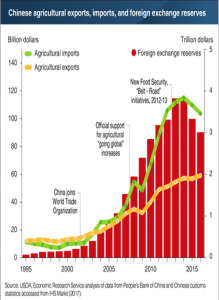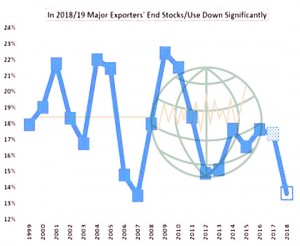- Chicago corn, soybean and wheat futures are higher in reduced holiday volume as wheat paces the gain on concerning Black Sea weather. Black Sea wheat futures rallied to end the week with rumors that several Russian exporters have pulled their fob new crop wheat offers. Other Russian wheat exporters are offering wheat, but at $2-4/mt higher prices. Grain traders in the Black Sea are starting to sit up straight and take notice of budding adverse weather. Chicago corn and soybean prices are higher with corn following the gains in wheat, while soybeans are pushing higher on Chinese demand. China has been actively seeking US soybeans ahead of meeting between US Commerce Secretary Ross and his Chinese counterpart on trade next week. The Chinese demand for US soybeans is encouraging short covering. Rumours abound that China is offering to expand their soybean reserves to initially cut their trade deficit with the US. We look for a stronger Chicago close heading into the US Memorial Day Holiday.
- Chicago brokers report that funds have bought 3,400 contracts of wheat, 2,200 contracts of corn, and 3,100 contracts of soybeans. In soy products, funds have bought 2,900 contracts of soymeal while selling 3,000 contracts of oil.
- FAS reported an optional origin sale of 165,000 mt of soybeans to China for the delivery in the 2018/19 crop year. FAS also indicated that 312,000 mt of US soybeans sold to China in the new crop year. We expects US soybean sales to exceed 1.0 million mt of (both crop years) in the weekly report Friday.
- The Brazilian truck strike is ongoing and broadening according to our information. Brazilian President Temer called off the strike late Thursday, and few striking truckers listened. The Brazilian Congress is trying to find enough funding to subsidise a drop in the price of diesel to no avail. Jet fuel at airports is said to becoming limited, which is the first impact of the walkout. Brazilian ag exports are so far routine, but should the strike last another week, concern would be developing.
- The midday GFS Black Sea weather forecast is little changed from the overnight solution. If there are any differences, they are wetter for the spring wheat areas with several frost/freeze events possible next week. Ukraine and SW Russian winter wheat areas remains dry, but there would be a chance of rain across Moscow and northern crop areas in the 11-15 day period.
- The midday GFS N American weather pattern is forecast to form/move across the Gulf and make landfall near New Orleans late in the holiday weekend. This tropical storm will produce heat across the Plains with temperatures reaching into lower 90’s to the lower 100’s. Showers return to the N Midwest next week with totals of .25-1.00”. The EU weather model has not been projecting any moisture to help wheat following the weekend blistering heat. The extreme warmth could cause acute stress on cattle/HRW wheat. The 11-15 day forecast is cooler than the overnight solution as trough retrogrades the mean position of the ridge to the west, before amplifying north again. Our confidence in this cooler GFS solution is low amid the complex nature of the overall pattern.
- The Black Sea forecast remains arid across Ukraine/ W Russia with cool/wet weather for Russian spring wheat areas. The White House is suggesting that a summit with N Korea is back under discussion. This would help US/China trade negotiations. We see wheat at the upside Chicago leader as Black Sea yield threats and extreme Plains heat.
To download our weekly update as a PDF file please click on the link below:
Our weekly fund position charts can be downloaded by clicking on the link below:


